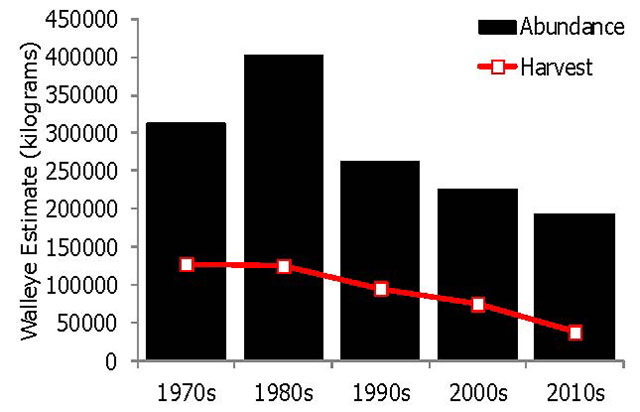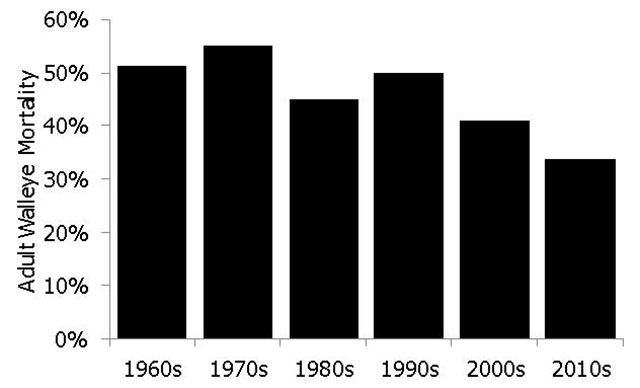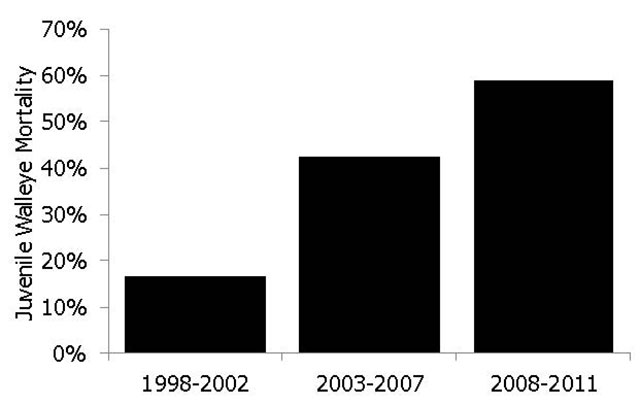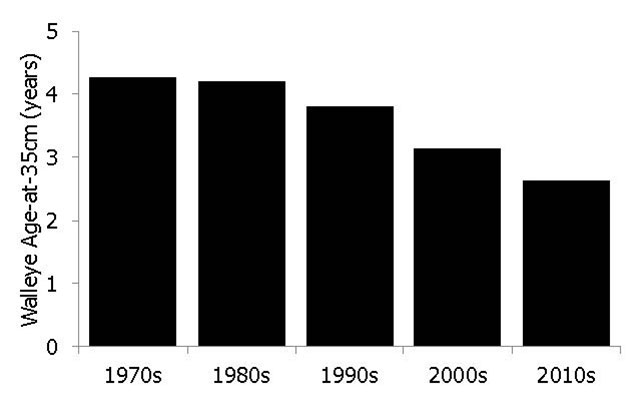Lake Nipissing walleye data review
The Lake Nipissing walleye data review. Data ranges from 1967- 2011.
In response to recent trends in the walleye population and concerns over potential changes in the aquatic ecosystem, the Ministry of Natural Resources initiated a review of all data on Lake Nipissing from 1967 to 2011. This report has undergone extensive peer review by a panel of fisheries researchers and First Nations. This fact sheet summarizes the main findings in the report.
Management history
During the 1960s and early 1970s, Lake Nipissing became an important destination for walleye anglers. This trend has continued to the present, with ice and open water anglers spending half a million hours each year pursuing this favourite sport fish. Data collection by the ministry began in 1967 with the first open water angler survey, and this program has evolved to include annual standard index netting projects, winter and open water angler surveys, and commercial harvest sampling. Many of these projects involve partnerships with nearby First Nation communities and stakeholders.
Trends in walleye harvest and abundance by decade
In the 1970s and 1980s, harvest of walleye on Lake Nipissing was very high, exceeding 100,000 kilograms per year throughout this period. In the 1990s, management reports identified that the annual walleye harvest target from the combined recreational and commercial fisheries should not exceed 100,000 kilograms. Walleye harvests were reduced slightly through the 1990s to 100,000 kilograms a year on average. Despite this harvest reduction, the population declined in the 1990s, likely due in part to high exploitation in earlier decades.
Concerns over this decline led to management actions in the mid-2000s to reduce the harvest to 66,000 kilograms per year. Nonetheless, walleye numbers are continuing to decline, with the current population half of what it was in the 1980s (Figure 1).
Figure 1

Walleye population health
Few inland lakes have been studied as long as Lake Nipissing. As a result, it is possible to see if there has been any change in walleye health associated with changes in abundance. Two of the most important indicators of walleye population health are mortality and growth.
Adult mortality
The loss of adult walleye (more than five years old) has varied between 30 and 55 per cent over the last five decades (Figure 2). Changes in mortality have been attributed to management actions. For example, the decrease in mortality from the 1970s to the 1980s appears to be related to a delayed spring angling opening, and a similar decline in the 2000s has been attributed to the reduced limits and protected slot size.
Figure 2

Juvenile mortality
Low adult mortality suggests that the decline in the Lake Nipissing walleye must be associated with changes in juvenile fish (younger than age five).
The data show a troubling pattern in juvenile mortality, with a dramatic increase over the last decade (Figure 3). Estimates of juvenile mortality are only available since 1998, when the standard fall index netting program began. Today, with more juvenile mortality, the abundance of walleye has declined to its lowest level and may continue to decline in the future.
Figure 3

Why has juvenile mortality increased when angling is restricted by the size and number of walleye that can be harvested and the commercial harvest is set by the quota and gill net mesh size? The answer lies in changes in walleye growth.
As the abundance of Lake Nipissing walleye declined, their growth has increased.
Walleye become vulnerable to harvest (by hook-and-line or gill net) at around 35 cm in length (13¾ in.). Since the early 1990s, the fish have reached this length at an earlier age (Figure 4). As a result, walleye are now becoming vulnerable to fishing at a much younger age, which means much higher juvenile mortality rates and fewer adult walleye in later years.
In spite of increased growth, walleye are not maturing earlier, so they are exposed to more years of fishing before they reproduce for the first time.
Figure 4

Summary
The Lake Nipissing walleye population is exhibiting many signs of a stressed fishery. Walleye abundance is too low to support the current harvest target of 66,000 kilograms per year. Although there have been other ecosystem changes, such as the colonization of Lake Nipissing by double-crested cormorants and the spiny water flea, fishing has placed the walleye population in a vulnerable state.
The ministry will need the cooperation of everyone with an interest in the fishery to reverse the decline of the Lake Nipissing walleye population. In July 2012, the ministry created an advisory committee of local stakeholders to develop recommendations to address the decline of walleye in Lake Nipissing, including examining ways to reduce exploitation on this population. With the help of local anglers, stakeholders, First Nations and fisheries experts, we will develop solutions to help this socially and economically important fishery rebound.
For more information please contact:
Randy McLaren, Nipissing Area Supervisor, MNR North Bay
3301 Trout Lake Road, North Bay, ON P1A 4L7
Or visit Fisheries management zones
July 2012